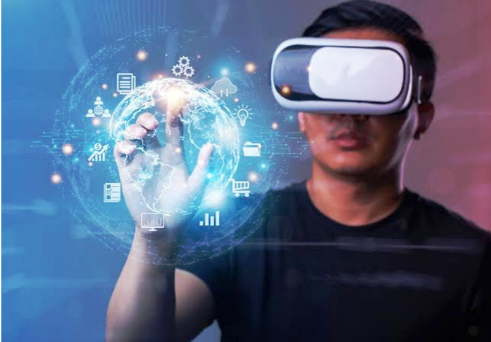When it comes to technological innovation, entrepreneurs constantly face the question: adopt or resist? Augmented Reality (AR) and Virtual Reality (VR) are no longer confined to gaming and entertainment. Their potential in the workplace is growing, and businesses are faced with a critical decision: to embrace these technologies or cling to the tried-and-true methods that have served us well for decades?
RELATED: Augmented reality can impede the optimization of production
AR and VR as a gamechanger in the Workplace
According to Frontier Economics, AR is a technology that blends real life and digital life by overlaying virtual sensory elements in the user’s physical environment, while VR uses headset-mounted displays to create an immersive audio-visual experience. The aim is to simulate the user’s presence in a virtual environment using images and sounds. Both AR and VR have unique capabilities that can reshape how tasks are performed in various industries. So, where do they fit in the professional space?
AR and VR have exciting potential applications across various fields.

In retail, AR is redefining the shopping experience. Customers can now try on clothes without entering a dressing room or visualize how a new sofa would look in their living room before purchasing. IKEA’s AR app, for example, allows customers to virtually place furniture in their homes before making a selection, enhancing decision-making and reducing returns.
In the tech and media sectors, AR and VR are transforming engagement. Media companies are using VR for immersive storytelling, letting audiences step inside a story or experience a documentary firsthand. Meanwhile, tech giants are leveraging AR for product demonstrations and interactive user manuals. A notable example is Microsoft’s HoloLens, which creates mixed reality experiences for both entertainment and practical applications, enhancing the way users interact with products and tools.
In manufacturing, companies like Boeing are employing AR to simplify complex assembly processes. Workers use AR glasses that project assembly instructions directly onto the parts they are working on, reducing errors and significantly increasing efficiency. This overlay of real-time data improves accuracy and speeds up production lines.

Healthcare is another sector experiencing the benefits of VR. Surgeons can practice complex procedures in virtual operating rooms, improving their precision and preparedness before performing them on patients. VR is also being used for pain management, offering immersive experiences that help patients find relief from chronic pain by distracting them from discomfort.

Where It May Fall Flat
While AR and VR technologies offer enormous potential, they aren’t a one-size-fits-all solution. For some industries, sticking to the status quo may make more sense. Take fine dining, for instance. High-end restaurants prioritize the sensory experience of dining. While AR might enhance menu presentation, extensive use of such technology could detract from the core dining experience.
Similarly, in professional sports, the fast-paced, physical nature of many sports limits the practical application of AR/VR during actual gameplay. However, these technologies are finding use in training and fan engagement.
There is also traditional craftsmanship. Artisans working with physical materials (e.g., woodworkers, tailors) rely heavily on tactile feedback and years of hands-on experience. While AR might assist in design visualization, it’s unlikely to replace the core skillset.
The performing arts is another example. Theatre, dance, and music thrive on the electric connection between performers and their audience. While AR and VR might revolutionize stage design or rehearsal processes, their use during live performances remains limited. In high-stakes environments like emergency services, the need for clear, unobstructed vision and immediate situational awareness makes current AR and VR technologies impractical.
Even in traditional sectors such as law, consulting, or certain areas of finance, AR and VR might seem out of place, or even distracting. Industries driven by personal, face-to-face interactions—like counseling or customer service—depend on human connection, which these technologies could inadvertently hinder rather than enhance.
To Adopt or Not?
The status quo may seem safe, but it carries its risks. Businesses that resist innovation could be left behind as competitors leverage AR and VR to improve efficiency, customer experience, and employee training.On the flip side, jumping into AR and VR without a clear strategy could lead to wasted resources if the technology doesn’t align with the business’s needs or industry standards.
Whether workplaces should adapt depends on the industry, business goals, and readiness to innovate. In sectors like retail, manufacturing, tech, and healthcare, AR and VR offer clear advantages and can help companies stay competitive. But in more traditional fields, they might seem excessive, making the status quo seem like a smarter option for now. The key is to recognize where these technologies can truly add value and where they might be more gimmicks than game-changers, and sometimes, for many businesses, the sweet spot lies somewhere between total adoption and complete rejection.
What do you think about applying Augmented Reality and Virtual Reality in your industry? Please share your thoughts.
COVER PHOTO: Getty





























